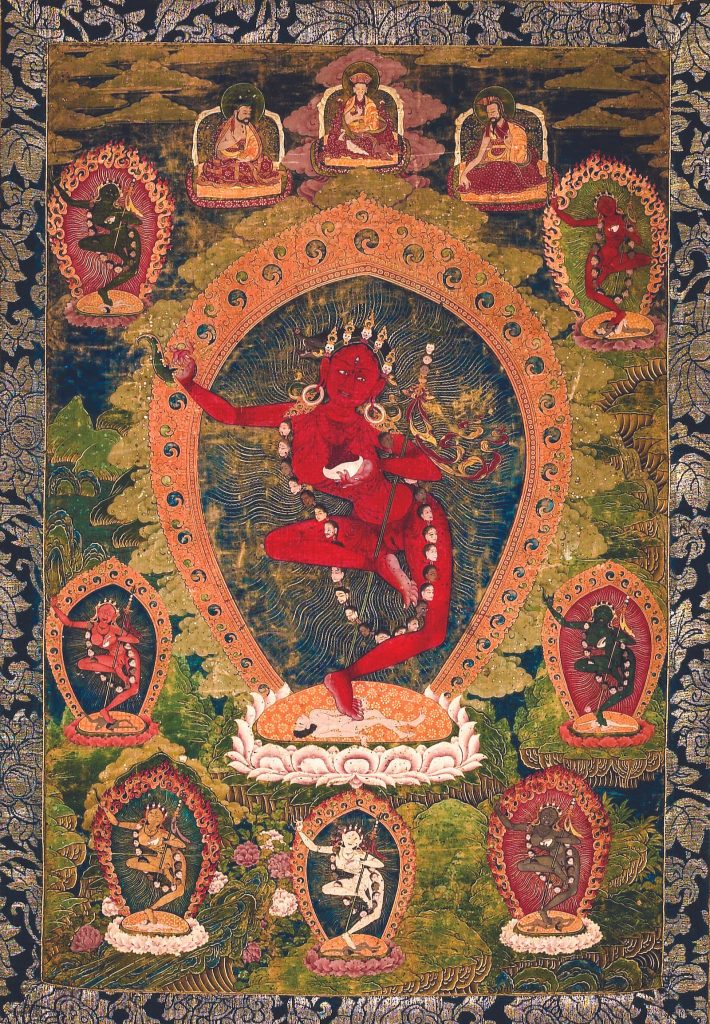The red dancing figure seen here is the dakini Vajrayogini, a Tantric deity who is the female counterpart to Chakrasamvara, the chief deity of the Chakrasamvara Tantras, an important collection of Buddhist texts and practices.
Vajrayogini is one of the most important, most often reproduced figures in Himalayan art, sculpture, and painting, going back as early as the 8th or 9th century. This particular image is from Bhutan and dates to the 19th century.
But what exactly is a dakini? As with all Tantric deities, representations of dakinis have three meanings: outer, inner, and secret. The outer meaning will be discussed here. Practitioners can learn the secret meanings of Tantric deity representations only when they complete more profound teachings on the practice, and this may require retreats of three months, six months, and so on.
There are three types of deity appearances: peaceful, wrathful, and then semi-peaceful/semi-wrathful, which falls somewhere in between. This depiction is the third type and is also referred to as Vajravarahi, which refers to the sow’s head next to the face, described below.
Vajrayogini dances atop a prone figure, representing the ego. In Tantric Buddhism, one practice is to meditate on oneself as a deity. The purpose of this practice is to open up the mind to the idea that we don’t have to be who we usually think we are—a samsaric delusional being. We can be something else, and to do that, we have to suppress the ego, which we see here being trampled underfoot. This prone figure should not be looked at literally as a dead body.
In her right hand, Vajrayogini holds a hooked blade, a knife used for skinning, and it has a vajra handle. (If you’ve ever seen someone skin a deer, then you know that you don’t use a straight knife.) In her left hand, she has a skull bowl, and it’s full of what looks like blood and is generally described as the blood of the four Maras, tempters who need to be defeated along with the ego. She also has a khatvanga staff in the crook of her arm. This staff is a stand-in for Vajrayogini’s consort, the wrathful aspect of Chakrasamvara, as well as the other deities of the mandala. Its presence indicates that she is part of something larger.
Vajrayogini is one of the most important, most often reproduced figures in Himalayan art.
To the left of her face, which is her right side, there is a sow’s head. Vajrayogini is also called, in Tibetan, shal nyi ma, meaning two-faced, because of these two heads. And of the two heads, the sow’s head is more important, because the main face represents relative truth. The sow’s head represents the ultimate truth, since sows often find food under the ground that no one else can see. This is a metaphor for digging out the ego and reaching enlightenment.
She also wears a garland of fifty freshly severed heads, representing the Sanskrit alphabet. At least, that’s one meaning of the severed heads. The secret meaning is accessible only to students of the tantra.
At the top of the composition, the lama with the blue hat is a Gyalwang Drukchen. If you meet the current Gyalwang Drukchen, who lives in Ladakh, you’ll see that he often wears this blue hat. This is one of his predecessors from the 19th century. All three figures are Bhutanese teachers from the same era.
Several figures surround Vajrayogini. These are her retinue, other yoginis from the Chakrasamvara Tantra. The presence of these figures indicate that Vajrayogini practice is just one part of a larger collection of practices.
An interesting feature of this representation is the dakini at top right dancing on her right leg. This is a highly unusual depiction, since usually only males are depicted this way. The others in this image conform to the depiction, in which dakinis dance on the left leg.
Dakinis emerged from Indian culture, particularly Shaivism, the worship of Shiva. To this day in India, “dakini” refers to a class of cannibalistic, blood-drinking witches. They generally inhabit cemeteries and charnel grounds. Shiva and Durga were said to have hordes of followers called dakini—witches and women warriors—who eventually developed into higher sorts of beings, and Buddhism took the concept from here. The ambivalent nature of dakinis, sometimes helping and sometimes harming humans, is meant to caution practitioners to avoid dualities.
It is common today to see “dakini” used as an epithet, a term of respect and endearment. But the word and its representation are tied to specific practices and have specific meanings in the correct context. Attempting to generalize them leads to confusion.
Thank you for subscribing to Tricycle! As a nonprofit, we depend on readers like you to keep Buddhist teachings and practices widely available.
